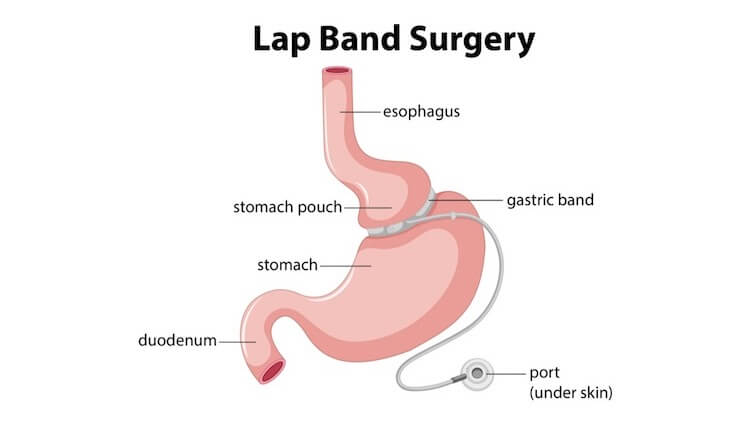Laparoscopic Band Surgery (also known as Lap Band Surgery) is one of the most effective ways to lose weight. Particularly since 2001, when the US Food and Drug Administration Authority approved the procedure, an increasing number of people have begun opting for the surgery.
Although the surgery is used as a last option when no other treatment has worked, lap band surgeries are sure to help you meet your weight loss goals. The Lap-Band surgery costs $7,700 per procedure and presents a very affordable solution to your weight problems.
In this article:
What is a Laparoscopic Band Surgery?
Cost of the Procedure
Is the Lap Band Surgery Safe?
Who is the Lap Band Surgery For?
Benefits of the Procedure
Possible risks and side effects
Preparing for the Surgery
What diet is required after the surgery?
What are the alternatives?

What is a Laparoscopic Band Surgery?
Laparoscopic Band Surgery is a surgical intervention conducted when people become morbidly obese. The surgery is carried out with the intent to reduce food intake, to stop overeating and therefore the weight gain.
Patients are also required to keep up with physical fitness regimens and switch their eating habits to ensure long term physical fitness. Once they’ve met their weight loss goals, the patients go through a lap band removal surgery and required to commit to frequent follow-ups to ensure a healthy recovery.
Pre Operative Procedures
Although only the morbidly obese can receive lap band surgery, doctors conduct a comprehensive medical assessment to mitigate any risks of complications from the surgery. There are also other surgical options available too, such as bariatric surgery and a gastric bypass.
If you ever do go for the procedure, expect your doctor to conduct the following tests:
- Blood Panels that assess glucose content, cholesterol content.
- Weight and BMI measurements
- Kidney and Liver functioning profiles along with Urine analysis.
- Cardiopulmonary screenings include chest x-rays, ECG and testing for sleep apnoea.
- Gastrointestinal evaluations to check for infections of the stomach, ulcers, and inflammation.
- Endocrinal Evaluations including hormone level checks and diabetes tests.
- Nutritional Evaluations.
- Psychological Evaluations.
- Smoke Cessation Counseling.
Each of these tests will help your doctors determine your viability for a lap band surgery. During the course of these tests, if any abnormalities are found, you will be treated for those first before surgery.
Operative Procedures
A laparoscopic band surgery effectively creates two compartments in the stomach. Your surgeons will attach an adjustable elastic band around your stomach, which will almost close off a section of the stomach. The band will restrict the passage of food from one section of the stomach to the other and will make you feel fuller faster.
In addition to the band, your surgeon will also attach a port through the skin that will allow you to inflate or deflate the band based on your requirements.
The band itself is filled with saline, to inflate it and compartmentalize your stomach into two separate sections. The surgery takes 60 minutes and is conducted under the influence of anesthesia. You will be allowed to go home after resting in the hospital for one day.
You may also watch the video presented below to get an idea of what the procedure looks like:
Post Operative Care
After the procedure, you will be required to come in for regular follow-ups to make sure that you heal properly from the surgery. These tests will also keep on monitoring your weight loss to assess when you could have the lap band removed and will be used to provide guidance on your nutritional habits.
Lap Band Removal
A lap band is not a permanent weight loss aid and is removed when you’ve significantly reduced your weight. In the process of your post-operative assessment, your doctors will continually monitor your weight loss progress.
In time, once you’ve reached healthy weight levels and your doctors are certain that you can maintain the weight without a band, you will undergo a lap band removal surgery. It’s a simple 10-minute procedure that your doctor will conduct under general anesthesia.
Cost of the Procedure
Laparoscopic band surgeries are priced between $8,800 and $22,000 in the United States. The average lap band surgery cost is currently $14,532, but costs generally decrease slightly every year. Depending on whom you go to and the duration of post-operative care procedures, these costs vary. Of course, there are also overseas options that you can opt for, where the costs are lower.
If you’re interested in these options then here’s a listing of Laparoscopic band surgery costs around Europe:
- In Spain, prices start from €1,760.
- In Belgium, a full treatment plan can cost €4,000.
- In Prague, a full treatment plan costs €5,340.
- In Scotland, prices can be below £5,900 to over £9,800.
- In the UK the prices can vary between £5,000 and £8,000.
Is the Lap Band Surgery Safe?
Lap Band Surgeries are considered one of the safest options out of all other bariatric surgical procedures. Compared to the gastric balloon, which poses risks like oesophageal perforation, visceral perforation; these risks are minimal with a gastric band. In fact, the Lap Band Surgery is one of the least invasive surgical options available to you.
The literature on the effectiveness of lap bands is immense, prompted by the periodic evaluations required by governing authorities around the world. In the United States, the approval to conduct a lap band surgery is conditional on annual evaluations of the procedure itself.
Besides these governmental efforts to regulate the use of gastric bands, numerous pieces of independent research point continually point out the effectiveness of the procedure. One particular piece of research studied the safety of the bands over a 3-year period and found that it is absolutely safe over the time duration.
The Bariatric and Metabolic Centre of Colorado created a comprehensive list of risk factors and statistics on the complications resulting from a Lap Band Surgery. The findings of the study concluded the following facts:
- 2 in 100 patients suffer from band erosions. This occurs when the band starts eroding into the stomach lining.
- 6 out of 100 patients are incompatible with the band.
- 4 out of 100 people get infections because of the band.
- For 22 out of 100 people the band slips to cause complications.
- 14 out of 100 patients might develop acid reflux after 7 years of living with the band.
- 4% of all the patients suffer from band leaks.
- 20% of all patients might need port replacements for any problems with the port.
These statistics point out the incredible success of the surgery considering how easily each of these complications can be reversed. Furthermore, only 3 out of 10,000 people actually ever die because of a complication from lap bands.
Who is the Lap Band Surgery For?
Even though the lap band surgery is very effective in terms of helping people achieve their weight loss goals, it’s hardly ever used for non-obese patients. The surgery might be very safe, that still doesn’t change the fact that it is a form of mechanical intervention which shouldn’t be taken lightly.
As such, there are some very strict guidelines that determine whether someone qualifies for the surgery or not. The National Institute for Health and Care excellence has outlined a thorough set of procedures that medical professionals should follow before clearing people for the lap band surgery. This includes:
- Anyone wishing to get a Lap band surgery should have a BMI of over 40 kg/m2
- The surgery may also be considered for patients who have a BMI between 35 and 40 kg/m2 if they have also been diagnosed with type 2 diabetes. This criterion also requires doctors to ensure that surgery will definitely help the patient.
- The procedure is to only be considered if all other lifestyle and pharmaceutical procedures have been tried, but failed to affect weight loss.
- The person in question has received or will be receiving treatment in a top tier facility to ensure weight loss.
- The person can withstand general anesthesia and surgery, without suffering from complications stemming from the surgery itself and/or the anesthesia.
- The patient should also commit to long term follow-ups and post-operative care.
Benefits of the Procedure
In addition to the relative safety of the procedure, there are numerous advantages of using the lap band. People stand to lose as much as 40%-60% of their weight after a lap band, assuming that they follow through with the lifestyle changes they are supposed to make. The fact of the matter is that it’s very unlikely that anyone can’t manage those lifestyle changes since the consequences of negligence can be severe. This offers a lot of therapeutic value to the lap band surgery since it almost always ensures that people overcome their obesity.
With the increased effectiveness of the Laparoscopic Band, there are other advantages that you can benefit from if you choose the procedure. These can include:
- The surgery is minimally invasive, does not take up too much time and recovery times are very small.
- There are no surgical, non-reversible changes from undergoing the surgery. The effects can be easily reversed with a simple 10-minute removal procedure.
- There is very little risk of nutritional deficiencies. Compared to gastric balloons, a Lap band is adjustable to help overcome any such deficiencies.
- There is no risk of developing the dumping syndrome, which is a common side-effect of a gastric bypass. This condition occurs when the food moves too quickly through the stomach into the bowels.
- The adjustable band can help create the ideal food intake routine to expedite the weight loss procedure.
- These adjustments can be performed without having to undergo more surgery.
- The band can also be used during pregnancy.
Possible risks and side effects
Anyone who’s considering getting a Lap Band surgery might be convinced that it is a relatively safe procedure, it is a surgery nonetheless. As such, there are still certain risks associated with the procedure. Your doctors will take all the possible measures they can to avoid those risks, but you ought to still be prepared for the possibility that the following complications may occur:
- Complications from Anaesthesia
- Bleeding from your surgery
- Infections from your surgery wounds
- Injuries to the bowel or the surrounding body parts like the liver and pancreas
- Band Slippage. Sometimes the band slips from the stomach and may lead to complications like regurgitation and acid reflux.
- The lap band might erode into the stomach lining.
- The band might deflate due to problems with your inflation ports.
- Stomach pouch enlargement from band slippage.
- Stomach outlet blockages because of inflation.
- You might have to go through open surgery if a laparoscopy doesn’t work out.
- Blood clots that might lead to further complications of the lungs, heart, and brain.
In addition to these risks during the surgery, there are certain side-effects of the surgery. These you will face once you’ve undergone the lap band surgery. These effects are long-term, in that you might have to live with these effects for as long as you live with a lap band:
- Nutritional Deficiencies from the separation that reduces food intake.
- Your gastrointestinal system might become compromised from continued use of the band, which might need corrective surgery.
- You might face emotional symptoms like mood swings and hormonal fluctuations as you lose weight.
Preparing for the Surgery
A large part of the risks is reduced if you choose to work with a skilled bariatric surgeon. Most of these are already mitigated if you clear your pre-operative medical assessment anyway. The complications that we spoke of above apply to the more serious cases where pre-existing medical conditions complicate the surgical procedure.
However, a large part of the risk mitigation is also in your hands. Your doctors will provide you with an extensive set of dietary and health-related guidelines to help prepare you for the surgery. This includes trying to change your dieting habits to reduce the size of the liver to prevent complications, increasing your energy levels and getting a head start on the post-operative diet.
Before your surgery, you should follow these steps as part of your lap band surgery diet:
- Eliminate all carbohydrates from your diet, this includes bread, baked goods, rice, and similar carb-heavy foods.
- Do not eat processed foods before the surgery.
- Begin to include lean proteins like vegetables and lentils into your diet.
- Drink 8 glasses of water a day.
- Eat slowly and recognize when you feel full to be also prepared for your meal reduction after the laparoscopic band has been installed.
- Do not drink before your surgery.
- Quit smoking entirely before your surgery.
- Add vitamins and mineral supplements to your diet.
- Begin preparing for your follow-up fitness regimen.
- Right before the surgery, you will also be put on a liquid only diet.
What diet is required after the surgery?
Once you’ve successfully undergone the surgery, there are two goals to your dietary plans. The first is to help you become accustomed to your new lap band and the second is to help you change your dietary habits for good.
In the days following your surgery, you will be put on a full liquid diet to help you transition into your new lifestyle. Once your doctor has cleared to eat solid foods, your eating habits should include the following precautions:
- Eat smaller portions of food because overeating will put a strain on your stomach and the band. This may lead to slippage or regurgitation.
- Switch to a low carbohydrate and high protein diet to meet your weight loss goals.
- Do not drink and eat at the same time.
- Add more fruits and vegetables to your diet.
- If possible do not eat foods high in carbohydrates at all.
What are the alternatives?
If for some reason you do not qualify for a Laparoscopic band surgery, there are other surgical and non-surgical options that you can go for to help with your weight loss. These include:
- Gastric Bypass
- Gastric Balloons
- Gastric Sleeves
- Weight loss medications
- Dietary and lifestyle changes
Conclusion
A laparoscopic band surgery is a great weight loss option that ensures long term weight loss for a large number of people. Given the easy access to the surgery and the low-risk rates, as well as the relatively affordable rates of the surgery; it’s perhaps also the best option.
Consult with your primary healthcare provider to consider the option to help you reduce your weight to healthy levels. As you begin to lose weight, you will successfully avoid developing conditions like diabetes, high cholesterol, hypertensive disorders, and arthritis.
In addition to benefits, you also stand to gain much emotional and psychological relief where you will be more active, energetic and feel good about yourself. With these benefits, a laparoscopic band surgery is a holistic treatment option for your obesity.
PhenQ manufactures natural supplements to aid weight loss that you can use to expedite your weight loss treatments. In addition to this, we also offer advice on the best ways that you can lose weight and maintain your health. Have a look around our website for more information on our weight loss products or to read our articles on how to live a healthy lifestyle.




